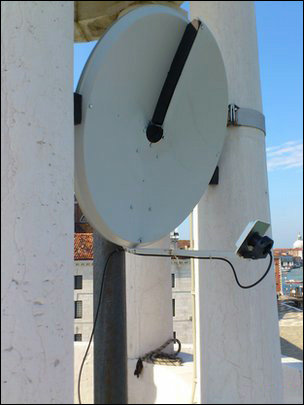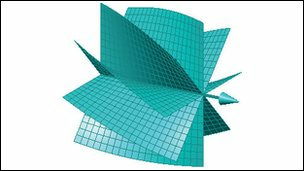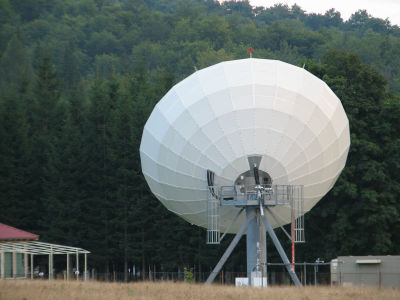With the helical beam communication technology, the communication speed reaches 2.5 Tbps, and in the future there is no need to worry about bandwidth problems

ByErathic Eric
The amount of wireless communication globally has become enormous, and the communication in the specified band is reaching the limit. Research on "helical beam communication technology" that can solve it at a stroke and speed up the communication speed to 2.5 Tbps (about 320 GB / s) is entering a new era.
BBC News - 'Twisted light' carries 2.5 terabits of data per second
Infinite-capacity wireless vortex beams carry 2.5 terabits per second | ExtremeTech
Vortex radio waves could boost wireless capacity "infinitely" | ExtremeTech
This technology is jointly being studied by Professor Alan Willner, the University of Southern California University, NASA's Jet Propulsion Laboratory, and Tel-Aviv University.
Current wireless communication can not perform multiple communication at the same frequency. This is because radio waves are adjusted only with SAM (spin angular momentum) information, and Wi-Fi, LTE,COFDMNot only the latest communication technologies such as radio and television are similar. However, in fact, it is possible to have information on OAM (orbital angular momentum) at the same time as SAM with radio waves.
Although it does not understand suddenly "angular momentum", it is SAM which is used for rotation (rotation of the earth along the earth's axis), it is used for revolution (the earth turns around the sun) is OAM is. Radio waves can also have SAM and OAM at the same time as Earth does both rotation and revolution at the same time.
Swedish physicistBo ThidéHas studied for four years in partnership with a Swedish laboratory and an Italian research team and proved that it is possible to communicate more than once on the same radio frequency. Thidé used the method of making a spiral data stream by adding OAM to radio waves (Thidé, so to speak, "radio vortex" (spiral radio)), the two streams in Venice at the same frequency at the same time, 442 m I succeeded in receiving it at a distance.
This is the antenna (sender) used in the test. It seems like a joke, but it just cuts in a standard parabolic antenna and twists slightly. It seems that it is OK with the image that the radio wave fly like a corkscrew.

On the other hand, the receiving side has two ordinary television antennas (Yagi · Uda Antenna)use. When installing a transmitter and setting it to the same angle, it receives and decodes "spiral radio" with the antenna.
Willner 's team are able to create wireless communication protocols that use both SAM and OAM is a major advance. Professor Willner's team used eight visible light ray data streams of 300 Gbps in the experiment. Each of these eight beams is subjected to a different level of OAM twist to form one large helical beam. The transmitted beam was processed through the open space, decoding the spiral at the receiver 1 m ahead.
It is composed of a helical beam.

The real thing seems to be like this.

The communication speed in this experiment is 2.5 Tbps (terabit per second). Converted it was speed enough to transfer 320 GB / s, ie 7 Blu-ray movies in 1 second. This feat was accomplished in just a few months since it proved possible to add OAM to radio waves by Thidé. According to Thidé's words, in the short term OAM will improve the speed by 10 times to 20 times even with current wireless communication, and in the long term understanding OAM deeply understands the bandwidth available for wireless communication is infinite It will spread to.
By the way, Professor Willner's OAM linkSystem spectral efficiency(The higher the number, the higher the maximum throughput) is 95.7 bit / s / Hz / site. This value is 16.32 for LTE, 2.4 for Wi-Fi (802.11n), 0.55 for digital TV broadcasting (DVB-T).
Initially, Verizon and Vodafone invested billions of dollars against just a few megahertz, and SOFTBANK was burning with the acquisition of the platinum band because getting that bandwidth is a life and death problem for telecommunications carriers. However, if Thidé's research goes well, the bandwidth problem will not only become nearly worthless, but also the 4 G LTE operatorLightSquaredIn the same way, problems such as dislocations in the surroundings, international roaming, etc. are cloudy.
The next task imposed on Professor Willner's team is to extend the present condition that the communication distance of helical beam communication is only 1 m to a level that can be used a little more. Professor Willner thinks that this technology can be used if the distance is less than 1 km in the future when high capacity communication is required. The problem in this technology is turbulence of the atmosphere, so in the universe where such things do not occur, it is expected to be used for inter-satellite long distance communication.
Actually, the main limitation factor of this technology is that we are in the place where we do not have the hardware and software for processing OAM, technology is established within a few years and wireless communication will have a bright future It is considered to be.
Related Posts:
in Science, Posted by logc_nt







